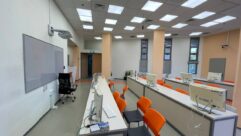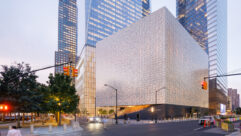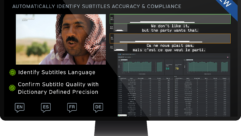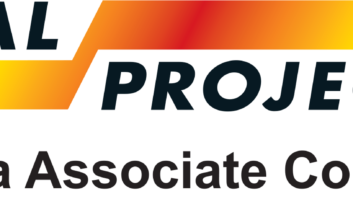Simply impressiveThe beauty of the new technology used at the Baltimore Convention Center is in the simplicitythat it affords.
Nov 20, 1996 12:00 PM,
Sam McDonaldMcDonald is an author who writes infrequently in the sound and video field.
Look behind the impressive new facade of the expansion to the Baltimore Convention Center, and you’ll find some equally impressive new audio technology that clearly reflects the growing importance of sound reinforcement at exhibition and meeting facilities.
Under the direction of the Maryland Stadium Authority, the $110 million expansion project more than doubles the size of the original convention center. Cochran, Stephenson & Donkervoet of Baltimore served as the principal architectural firm, bringing in Acentech of Cambridge, MA, early in the process to provide acoustic and system consultation. Later in the process, Signal Perfection Ltd. (SPL) of Columbia, MD, joined the team to provide design tailoring and system installation, with company co-principal Fred Curdts serving as project engineer.
“The client, as usual, wanted the state of the art in audio-visual, with the emphasis on audio,” said Stephen Siegel of Acentech, primary consultant for the project. “The overall goal is to provide a level of capability that allows them to remain competitive in their market.”The convention center expansion facility comprises a main exhibit hall, a ballroom and 37 meeting rooms. The exhibit hall and the ballroom can be subdivided, with the computer-based control and processing of the audio systems providing convenient system reconfiguration to meet a wide variety of needs and applications.
New loudspeaker technologyIn the exhibit hall, a distributed ceiling system supplies high-quality paging as well as good music support for stage events that often use separate portable systems. The two sound-reinforcement entities can be interfaced and coordinated with fidelity; appropriate delay patterns for the ceiling system synchronize it with a portable system and with fidelity.
The key to this ceiling system is a new Eastern Acoustic Works (EAW) loudspeaker called the CP621, developed in consultation with Siegel. Working with Kenton Forsythe, EAW vice president of strategic product development, Siegel defined the parameters for the new loudspeaker based upon limitations that have long existed with coaxial and two-way loudspeakers traditionally used in large-scale distributed system situations.
Topping the list of parameters is a symmetrical 60° dispersion that would provide consistent coverage. Anything wider creates excessive level fluctuations between the center and fringe coverage areas, and anything narrower requires too many devices. In addition, a symmetrical pattern conforms to the square ceiling grid common to facilities of this type.
“Because we usually end up having the room design dictate that these loudspeakers be laid out in a square ceiling grid, it’s tough to make a device with a rectangular pattern perform optimally,” Siegel said. “If we could use a device with a 60° square or conical-type pattern, performance would be much better”Taking other defined parameters into consideration as well, the result was the CP621, which EAW terms a Concentric Phase Aligned Array (CPAA). Essentially, CPAA technology turns the conventional coaxial concept inside out. Rather than a large cone woofer surrounding a small horn, a large-axis symmetrical horn flare surrounds the low-frequency section, which consists of a number of smaller cone transducers mounted within the flare.
The larger horn mouth opening extends the range of consistent pattern control downward by an octave compared to coaxial systems. The multiple woofers mounted around the horn flare provide the radiating diameter of a 21-inch woofer, which enhances directivity in the lower octaves.
To smooth response in the crossover region, two additional woofers are mounted within the horn’s throat. They are phase aligned with the other woofers to cancel reflections from the horn throat; because their output is coupled to the horn, they have enhanced directivity and alleviate lobing near the crossover transition point.
“We were looking for a different and better loudspeaker solution for situations of this type,” Siegel says. “Both two-way cluster and coaxial approaches offer their share of plusses and minuses. This new approach provides performance much better than a coax and more like a cluster but at a lower cost.”SPL mounted more than 125 CP621s, equipped with 70 V transformers, using eye bolts with the loudspeaker rigging points connected to aircraft cable. They are just above the drop ceiling, about 30 feet (9 m) above the floor on 30 foot centers, and are concealed by panels that blend in with the ceiling. The total loudspeaker count and the spacings between them worked out to be exactly the same, so both the architectural design goals and the sound design goals were met.
Crest CKV series power processing amplifiers with constant-voltage processors provide power for the exhibit hall and ballroom systems. A range of processing options are available in plug-in card form, which then can be programmed for stand-alone operation or linked to a PC loaded with Crest NexSys version 3.0 software. The NexSys system provides remote monitoring and control of a range of functions.
The system was originally specified with Crest’s MAS (Modular Audio System) convection-cooled, card-frame amplifiers because of budget constraints. Months after the original design was submitted, the consultant recognized that the newer, more advanced CKV series amplifiers could be offered as an alternative package with NexSys 3.0 for the same cost as the MAS amplifiers without NexSys.
SPL chose this equipment because the company perceived CKV’s networking capabilities to NexSys and its sequential power control and PowerSave features as beneficial.
Highly advantageousRather early in the design process, the sound team proposed computer-based control of audio systems throughout the new building. The client investigated several other facilities and decided an approach of this type would be highly advantageous.
A computer-control design was conceived to allow the various audio systems to be configured for room combining, paging and so forth. SPL recommended the MediaMatrix system from Peavey Electronics to handle these duties.
“When we were first conceiving the system, MediaMatrix didn’t exist,” Siegel said. “But during the bidding process, it started to become a viable product that SPL proposed as a cost-saving alternative. We agreed it would be a good choice for this application.”MediaMatrix comprises a mainframe, a hard drive and DSP cards to provide comprehensive signal processing. Break-out boxes linked to the mainframe supply inputs and outputs (eight of each per box). This project used 39 boxes and two mainframes. User-definable MediaMatrix software in a Windows format is used to establish and alter the system configuration.
Actually, two separate MediaMatrix systems were installed in this project: one for the ballroom and the other for the exhibition halls, meeting rooms and general paging. Each system is in its own control room, but the two are linked together via Ethernet so either one can control the other. Two additional PCs act as terminal stations to provide the system operators remote access to MediaMatrix from various ports in the building.
Custom featuresFor both systems, MediaMatrix provides functions such as automatic mixing, automatic gain control, digital delay, equalization, compression and limiting. However, some custom features, via the software, were implemented before and during the installation process. Acentech supplied an overview of the additional features it wanted, with SPL handling the bulk of the software programming and tailoring. Peak Audio, developer of the MediaMatrix software, provided some new, unique functions.
The custom package includes an automatic three-dimensional digital delay setting for use with multiple staging areas. With this feature, used when a separate reinforcement system is added, the stage location can be selected at the MediaMatrix control screen, which then automatically calculates the delays of each loudspeaker based upon the three-dimensional Cartesian coordinates for the ceiling loudspeakers and possible stage locations.
In addition, specialized room combining and volume control algorithms were added. The latter tracks the outputs of more than 100 Oxmoor RC-16 shaft-encoder-type volume controls used throughout the facility to provide individual volume adjustment.
Small control closets in the exhibit halls provide an extra measure of control. Each closet hosts a rack with a volume control, a panel that facilitates room combining and a patchbay for some of the mic-line circuits in floor boxes at various points throughout the facility. This allows many of the normal system changes to be made locally rather than necessitating a walk back to the master control rooms.
Another special MediaMatrix feature that Peak Audio developed for this project is what Siegel called “a very sophisticated preset handler.” It allows the users to set up a configuration for the building or a portion of it ahead of time and then enter the scheduled time for the event. MediaMatrix will then automatically change the system configuration at that time.
Emerging trendThe ballroom, which, like the exhibit hall, can be divided into four separate rooms, contains a system capable of providing concert-level sound reinforcement that can support stage events. Again, the ballroom features a distributed approach, with both EAW CH461 loudspeakers and EAW SB250 dual 15 inch (381 mm) loaded subwoofers mounted in the ceiling.
“It’s the first time we’ve seen something with concert-type output used as a ceiling loudspeaker system,” SPL’s Curdts said. “It’s certainly one of the most extensive distributed ballroom systems, and it sure can get loud.”
Siegel explained that the design stemmed in part from a high level of architectural design in the room, with the ceiling providing limitations when it came to location of loudspeakers. The client wanted such a system; an emerging convention center trend is a high-performance ballroom.
“We had to figure out how to get high audio quality given the constraints of the ceiling, so we looked at a number of product options,” he said. “The CH461 was the best fit both from the coverage and performance standpoints, as well as from a physical size standpoint.”Per quadrant, 12 of the two-way loudspeakers are distributed for a total of 48 for the room. The ceiling again interceded, dictating fewer subwoofers and located at different locations than the mid-high loudspeakers. Siegel said Acentech has successfully used this approach in the past.
The main control room for this system is nearby, keeping cable runs short, thus retaining fidelity. The ballroom also contains provisions for several snake systems that can accommodate up to 64 microphones simultaneously. The snake leads are linked to a portable console, which can also be patched into the MediaMatrix.
Beauty in simplicityThe beauty of the new technology is the simplicity it affords. Each system features a simple signal flow: digital processor to amplifiers to loudspeakers. Siegel said this is precisely the point.
“Our overall approach here was not to design overly complex systems,” he said. “The idea is to get systems providing plenty of functionality while delivering excellent audio.”










